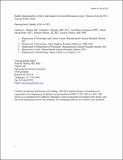| dc.contributor.author | Merker, Vanessa | |
| dc.contributor.author | Bergner, Amanda L. | |
| dc.contributor.author | Vranceanu, Ana-Maria | |
| dc.contributor.author | Muzikansky, Alona | |
| dc.contributor.author | Slattery, William | |
| dc.contributor.author | Plotkin, Scott Randall | |
| dc.date.accessioned | 2017-08-21T20:24:31Z | |
| dc.date.issued | 2016 | |
| dc.identifier.citation | Merker, Vanessa L., Amanda L. Bergner, Ana-Maria Vranceanu, Alona Muzikansky, William Slattery, and Scott R. Plotkin. 2016. “Health-Related Quality of Life of Individuals With Neurofibromatosis Type 2.” Otology & Neurotology 37 (5) (June): 574–579. doi:10.1097/mao.0000000000001019. | en_US |
| dc.identifier.issn | 1531-7129 | en_US |
| dc.identifier.uri | http://nrs.harvard.edu/urn-3:HUL.InstRepos:33788497 | |
| dc.description.abstract | Objective: To explore health-related quality of life (HRQoL) reported by individuals with neurofibromatosis type 2 (NF2) and to assess for correlations between HRQoL and objective measures of disease manifestations.
Study Design: Prospective observational study.
Setting: Seven international NF2 centers.
Subjects: Eighty-one individuals with NF2, 73 adults (>18 years) and 8 children/adolescents (10–17 years).
Outcome Measures: Quality of life was measured by Short Form-36 (SF-36) norm-based scores. Objective clinical measures were hearing (categorized by word-recognition scores), facial function (categorized by the House–Brackmann scale) and the volume of subjects’ larger vestibular schwannoma (VS).
Results: At baseline, adults showed significant deficits in all but two subscales of the SF-36 compared with age- and gender-adjusted United States population norms. In linear regression models including age, gender, inheritance status, hearing, facial weakness and VS volume, demographic and functional measures showed no relationship to any SF-36 subscale. Larger baseline VS volume was significantly related to reduced physical role performance, reduced mental health, and increased pain (p < 0.05). In bivariate analysis, previous VS surgery was not significantly associated with baseline HRQoL; receipt of VS surgery or tumor growth during the observation period was not significantly associated with changes in HRQoL.
Conclusion: NF2 patients report reduced HRQoL in physical, social, and mental domains, but this was not significantly related to objective measures of hearing or facial functioning. Larger baseline VS volume negatively impacted patient-reported HRQoL whereas VS surgery or tumor growth did not. Future studies should explore the relationship between tumor volume and HRQoL and psychosocial factors that may moderate this relationship. | en_US |
| dc.language.iso | en_US | en_US |
| dc.publisher | Ovid Technologies (Wolters Kluwer Health) | en_US |
| dc.relation.isversionof | doi:10.1097/MAO.0000000000001019 | en_US |
| dash.license | OAP | |
| dc.title | Health-related Quality of Life of Individuals With Neurofibromatosis Type 2 | en_US |
| dc.type | Journal Article | en_US |
| dc.description.version | Accepted Manuscript | en_US |
| dc.relation.journal | Otology & Neurotology | en_US |
| dash.depositing.author | Plotkin, Scott Randall | |
| dc.date.available | 2017-08-21T20:24:31Z | |
| dc.identifier.doi | 10.1097/MAO.0000000000001019 | * |
| dash.contributor.affiliated | Vranceanu, Ana-Maria | |
| dash.contributor.affiliated | Merker, Vanessa | |
| dash.contributor.affiliated | Plotkin, Scott | |


